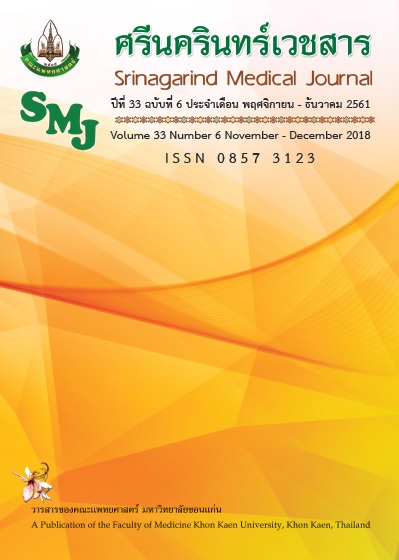Evaluation of Preceptor Teaching Behaviors in Pharmacy Professional Clerkship
Keywords:
Pharmacy student; Pharmacy Professional Clerkship; Pharmacy PreceptorAbstract
Background and Objectives: The number of pharmacy clerkship preceptors and their teaching behaviors may be different. This study aimed to compare the evaluation of preceptor teaching behaviors by pharmacy students based on the number of preceptors working with the student.
Methods: We performed a prospective study among the 6th year pharmacy students completing a clerkship at Warinchamrab hospital from May 8, 2017 to January 26, 2018. Students assessed preceptor teaching behaviors, with three categories by number of preceptors: one, two, and 4-7 preceptors. A questionnaire was used to evaluate preceptor teaching behaviors using a 5 point Likert scale: orientation, direction and feedback, evaluation, role modeling, and facilitating behaviors. Students were also allowed to provide comments and suggestions. Chi-square and Kruskal-Wallis H were used to compare the difference between each group.
Results: Among 127 questionnaires from 43 students, the score in the one and two preceptors group were not different. Students with 4-7 preceptor provided the lowest rating in all domains. The score in the 4-7 preceptors group was significantly lower than the group with one and two preceptors (p<0.05). Among the 5 domains, the lowest rated of three groups was orientation with strongly agree 78.8%, 71.7%, and 37.8%, respectively. Concerns raised pharmacy students included the high amount of preceptor workload and time allotted for case discussions with student during the day.
Conclusion: The increase in number of pharmacy preceptor per student affects the evaluation of teaching behaviors compared to one or two preceptors. However, workload and time spending for case discussion are limitation of preceptor in pharmacy clerkship.
References
2. ผกามาศ ไมตรีมิตร, เพชรรัตน์ พงษ์เจริญสุข, ณัฏฐิญา ค้าผล. คุณลักษณะและความสามารถที่พึงประสงค์ของเภสัชศาสตรบัณฑิต. วารสารไทยเภสัชศาสตร์และวิทยาการสุขภาพ. 2551; 3: 121-6.
3. วสวัต ดีมาร. “ประเทศที่นักเรียนไม่กล้าถามครูผู้สอนมากที่สุด" กับ "อันดับ ๖ ของนักเรียนไทย” [อินเตอร์เน็ต]. 2555 [เข้าถึงเมื่อวันที่ 18 มีนาคม 2560]. เข้าถึงได้จาก: https://www.gotoknow.org/posts/493702.
4. เบญจพร ศิลารักษ์. เภสัชศาสตร์ศึกษาสำหรับเภสัชกรแหล่งฝึกปฏิบัติงานบริบาลเภสัชกรรม (เอกสารประกอบการประชุมเชิงปฏิบัติการเภสัชศาสตร์ศึกษา 3 สถาบันภาคอีสาน โดยมหาวิทยาลัยขอนแก่น มหาวิทยาลัยมหาสารคาม และมหาวิทยาลัยอุบลราชธานี): การประเมินอาจารย์ผู้ฝึกสอน [อินเตอร์เน็ต]. 2555 [เข้าถึงเมื่อวันที่ 22 กุมภาพันธ์ 2560]. เข้าถึงได้จาก: https://drive.google.com/file/d/1BwxnngaYYslkA0VwdxP7xESDs-lWZ1Vg/view
5. Hamilton J, Stevens G, Girdler S. Becoming a Mentor: The Impact of Training and the Experience of Mentoring University Students on the Autism Spectrum. PLoS One. 2016; 11: e0153204.
6. Hawkins A, Jones K, Stanton A. A mentorship programme for final-year students. Clin Teach. 2014; 11: 345-9.
7. Raub JN, Thurston TM, Fiorvento AD, Mynatt RP, Wilson SS. Implementation and outcomes of a pharmacy residency mentorship program. Am J Health Syst Pharm. 2015; 72: S1-5.
8. Smith SM. Determining Sample Size: How to Ensure You Get the Correct Sample Size [Internet]. 2013 [cited January 10, 2018]. Available from: https://www.ndsu.edu/gdc/wp-content/pdf/Determining-Sample-Size.pdf
9. Sonthisombat P. Pharmacy Student and Preceptor Perceptions of PreceptorTeaching Behaviors. Am J Pharm Educ 2008; 72: 110.
10. คณะอนุกรรมการ การฝึกปฏิบัติงานวิชาชีพ ภาคบังคับ ศูนย์ประสานงานการศึกษาเภสัชศาสตร์แห่งประเทศไทย (ศ.ศ.ภ.ท.) 16 สถาบัน คณะเภสัชศาสตร์. คู่มือการฝึกปฏิบัติงานวิชาชีพเภสัชกรรมโรงพยาบาล. 2560.
11. Huang WY, Monteiro FM. Teaching behaviors used bycommunity-based preceptors for a family and community medicineclerkship. Fam Med. 2000; 32: 678-80.
12. Vos SS, Trewet CB. A Comprehensive Approach to Preceptor Development. Am J Pharm Educ 2012; 76: 47.
13. McClendon KS, Malinowski SS, Pitcock JJ, Brown MA, Davis CS, Sherman JJ, et al. A Multipreceptor Approach to Ambulatory Care Topic Discussions. Am J Pharm Educ 2014; 78: 77.
14. Young S, Vos SS, Cantrell M, Shaw R. Factors Associated With Students’ Perception of Preceptor Excellence. Am J Pharm Educ 2014; 78: 53.




